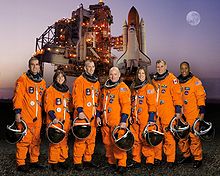
Back STS-118 Arabic STS-118 Bulgarian STS-118 Catalan STS-118 Czech STS-118 Danish STS-118 German STS-118 Spanish STS-118 Estonian استیاس-۱۱۸ Persian STS-118 Finnish
 Endeavour rendezvous with the ISS | |
| Names | Space Transportation System-118 |
|---|---|
| Mission type | ISS assembly |
| Operator | NASA |
| COSPAR ID | 2007-035A |
| SATCAT no. | 32008 |
| Mission duration | 12 days, 17 hours, 55 minutes, 34 seconds |
| Distance travelled | 8,489,253 kilometres (5,274,977 mi)[1] |
| Orbits completed | 201 |
| Spacecraft properties | |
| Spacecraft | Space Shuttle Endeavour |
| Launch mass | 121,823 kilograms (268,574 lb) |
| Landing mass | 100,878 kilograms (222,398 lb)[2] |
| Crew | |
| Crew size | 7 |
| Members | |
| Start of mission | |
| Launch date | August 8, 2007, 22:36:42 UTC |
| Launch site | Kennedy LC-39A |
| End of mission | |
| Landing date | August 21, 2007, 16:33:20 UTC |
| Landing site | Kennedy SLF Runway 15 |
| Orbital parameters | |
| Reference system | Geocentric |
| Regime | Low Earth |
| Perigee altitude | 226 kilometers (140 mi)[3] |
| Apogee altitude | 226 kilometers (140 mi)[3] |
| Inclination | 51.6 degrees |
| Period | 91.6 minutes |
| Docking with ISS | |
| Docking port | PMA-2 (Destiny forward) |
| Docking date | August 10, 2007, 18:02 UTC |
| Undocking date | August 19, 2007, 11:56 UTC |
| Time docked | 8 days, 17 hours, 54 minutes |

 (left to right) Mastracchio, Morgan, Hobaugh, Kelly, Caldwell, Williams and Drew. | |
STS-118 was a Space Shuttle mission to the International Space Station (ISS) flown by the orbiter Endeavour. STS-118 lifted off on August 8, 2007, from launch pad 39A at Kennedy Space Center (KSC), Florida and landed at the Shuttle Landing Facility at KSC on August 21, 2007.
This was the first flight of Endeavour since STS-113 in November 2002, which was also the last successful shuttle flight before STS-107 which culminated in the loss of Columbia when it disintegrated during reentry. STS-118 pilot Charles Hobaugh had been the entry team CAPCOM for STS-107. Columbia had originally been selected for this flight, for what would have been its 29th mission, and its first and likely only visit to the ISS, mainly due to its heavier weight.[4]
The mission is also referred to as ISS-13A.1 by the ISS program. The mission added two more components to the ISS and brought supplies for its crew.
During and after the mission, the media focused heavily on a small puncture in the heat shield, created by a piece of insulation foam that came off the external tank during liftoff, though the foam impact that ultimately destroyed Columbia caused more damage and was in a critical area. KSC Launch Director Michael D. Leinbach mentioned in the post-flight news conference that upon initial inspection on the ground, "Endeavour appears to be the 'cleanest' post-flight orbiter since Return to Flight".[5] On August 31, 2007, NASA reported that the damaged tiles had been removed in the Orbiter Processing Facility, and engineers had found no evidence of heat-related damage to the orbiter itself.[6]
- ^ NASA (2007). "STS-118 Mission Status Report #27". National Aeronautics and Space Administration. Archived from the original on December 23, 2007. Retrieved November 26, 2007.
- ^ NASA (July 2007). "STS-118 Press Kit" (PDF). NASA. Archived (PDF) from the original on December 1, 2007. Retrieved August 22, 2007.
- ^ a b "ISS 13A.1 - Shuttle Endeavour (STS-118)". Space Newsfeed. Microcom Systems. August 12, 2007. Archived from the original on September 27, 2007. Retrieved June 6, 2014.
- ^ Gebhardt, Chris (June 29, 2010). "Structural Inspections Find Enterprise in Better Than Expected Condition". NasaSpaceFlight.com. Archived from the original on July 3, 2010. Retrieved July 4, 2010.
- ^ Bergin, Chris (August 21, 2007). "Endeavour's performance during re-entry classed as phenomenal". NasaSpaceFlight.com. Archived from the original on December 5, 2018. Retrieved August 22, 2007.
- ^ "NASA's Space Shuttle Processing Status Report". NASA. August 31, 2007. Archived from the original on October 29, 2007. Retrieved September 2, 2007.
© MMXXIII Rich X Search. We shall prevail. All rights reserved. Rich X Search